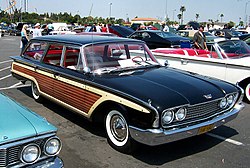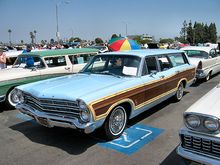Ford Station Wagon
| Ford Station Wagon | |
|---|---|
| Production period: | 1955-1968 |
| Class : | Upper middle class |
| Body versions : | Station wagon |
| Previous model: | Ford Mainline , Ford Customline , Ford Fairlane |
| Successor: | Ford Custom , Ford Galaxie , Ford LTD , Ford Fairlane |
The Ford Station Wagon series was a station wagon model from Ford , which was declared a separate series in the model years 1955–1968. Before 1955 and after 1968 these models were assigned to the respective sedan model series.
Models year after year
Models A5, U5, A6, U / M / P-6, A7, A8 and A9 (1955–1959)
| Station wagon models A5 / U5 / A6 U / M / P-6 / A7 / A8 / A9 |
|
|---|---|
|
Ford Parklane Wagon (1956) |
|
| Production period: | 1955-1959 |
| Body versions : | Station wagon |
| Engines: |
Petrol engines : 3.7-4.5 liters (88-151 kW) |
| Length: | 5019-5283 mm |
| Width: | 1928-1981 mm |
| Height: | |
| Wheelbase : | 2933-2997 mm |
| Empty weight : | 1498-1748 kg |
In 1955, the combination models, which had previously been assigned to the individual model series, were presented for the first time as a separate model series. Like their limousine counterparts, the cars had a trapezoidal shape, individual headlights above the wide radiator grille and clear tail fins with large, round taillights. The three-door models were called Ranch Wagon (base model) and Custom Ranch Wagon (top model), while the five-door models were divided into Country Sedan and Country Squire . Either a six-cylinder in-line engine with 3654 cm³ displacement, which delivered 120 bhp (88 kW) at 4000 / min, or a V8 engine with 4457 cm³ displacement at 4,500 / min served as the engine. 162 bhp (119 kW).
In the 1956 model year there were no significant changes in styling. The Custom Ranch Wagon became the mid-range equipment variant for the three-door models, while the top model was now called the Parklane Wagon . The six-cylinder increased by 17 bhp and now developed 137 bhp (101 kW) at 4200 rpm. The V8 engine also got a power boost and now delivered 173 bhp (127 kW) at 4400 rpm.
In 1957 there was a completely new styling with an even more pronounced trapezoidal shape. The headlights had received additional barges. The Custom Ranch Wagon and Parklane Wagon have been replaced by the new Del Rio , now the top of the range three-door model. The six-cylinder had increased power again and now brought it to 144 bhp (106 kW) at 4200 rpm, while the V8 engine 190 bhp (140 kW) at 4500 rpm. submitted.
The next major overhaul was due in the 1958 model year. Instead of the individual headlights , there were now double headlights lying next to each other and a narrower radiator grille, which was framed by the rectangular indicators. The basic equipment of the five-door was also called Ranch Wagon and the Country Sedan was the middle equipment variant. The Del Rio was omitted. The six-cylinder engine gained 1 bhp, the V8 engine a whole 15 bhp to 205 bhp (151 kW).
In 1959, the stylistic changes were rather minor: a slightly more angular front and even larger round taillights. The wheelbase was increased from 116 ″ to 118 ″ and the V8 engine only made 200 bhp (147 kW), but already at 4400 rpm.
In the first five years of the series, 1,177,066 station wagons were built.
Model V (1960–1968)
| Station wagon model V |
|
|---|---|
|
Ford Country Squire (1960) |
|
| Production period: | 1960-1968 |
| Body versions : | Station wagon |
| Engines: |
Petrol engines : 3.7-4.8 liters (99-147 kW) |
| Length: | 5309-5890 mm |
| Width: | 2070 mm |
| Height: | |
| Wheelbase : | 3023 mm |
| Empty weight : | 1729-1867 kg |
In October 1959 came a completely new styling. The double headlights were no longer above the radiator grille, but were integrated into the side. In the middle, the hood was pulled down slightly so that the grille appeared a few inches lower there. The wheelbase was increased to 119 ″. The output of the V8 engine dropped to 185 bhp (136 kW) at 4200 rpm. The three-door was only available in the simplest version, as a ranch wagon.
In 1961, the only one year old face of the Ford models was completely redesigned. The grille was now at the same height and had a wide, horizontal chrome bar in the middle. The engine output fell further: the six-cylinder engine only developed 135 bhp (99 kW), while the V8 brought it to 175 bhp (129 kW).
In 1962 the styling was just refreshed. The chrome rod in the radiator grille was omitted again. The 3-door station wagon models were also completely eliminated. The output of the six-cylinder rose again to 138 bhp (101 kW), that of the V8 fell further to 170 bhp (125 kW).
In 1963 the styling was refreshed again. The chrome bumpers became even more massive, the side decorations disappeared and a large Ford emblem was emblazoned in the middle of the wide aluminum radiator grille. The 5-door ranch wagons were also no longer offered, so that the Country Sedan now represented the basic equipment and the Country Squire the top model. The six-cylinder engine remained unchanged, while the new Challenger 289 V8 with 4735 cm³ displacement and 195 bhp (143 kW) at 4400 rpm powered the eight-cylinder models.
In 1964 the bodies were revised more clearly. The tail fins had disappeared, giving way to the sober design of the 1960s. What remained were the double headlights and the huge, round taillights. The engines were carried over unchanged from the previous year as was the range of equipment.
In 1965 came a completely new styling. The twin headlights now sat one above the other at the ends of the wide radiator grille with vertical chrome bars. There was again a 5-door ranch wagon as basic equipment. The new six-cylinder engine had 3,933 cc and developed 150 bhp (110 kW) at 4000 / min., The V8 engine had been bored to 4736 cc and delivered 200 bhp (147 kW) at 4400 / min.
Only small changes to the grille were seen on the 1966 models. Technically everything stayed the same. Even in 1967 there were small changes to the front of the vehicle.
In the 1968 model year, another major overhaul was due: The front featured a wide V-shaped radiator grille with twin headlights set in side by side. An elegant “hip swing” had crept over the rear wheel cutouts. The equipment was redistributed: the ranch wagon continued to be the basic equipment, with the new custom wagon above it . The top equipment of the six-cylinder model was the Country Sedan, which was also available as an eight-cylinder. The Country Squire was only offered as the top model in the eight-cylinder models. There were few technical changes; only the V8 engine now produced 5 bhp less (195 bhp / 143 kW at 4600 rpm).
From 1969 the station wagon models were again assigned to the individual limousine series. In the Custom / Custom 500 series there was a Ranch Wagon, in the Galaxie 500 series there was a Country Sedan and the Country Squire was reserved for the LTD series , while in the station wagon the Fairlane series was simply called Station Wagon.
In the nine years of the 1960s, 1,473,281 station wagons of the station wagon series were built (without the station wagons of the small Falcon series, which are counted separately to this).
Web links
literature
- Gunnell, John (Ed.): Standard Catalog of American Cars 1946-1975 , Krause Publications Inc., Iola (2002), ISBN 0-87349-461-X .





